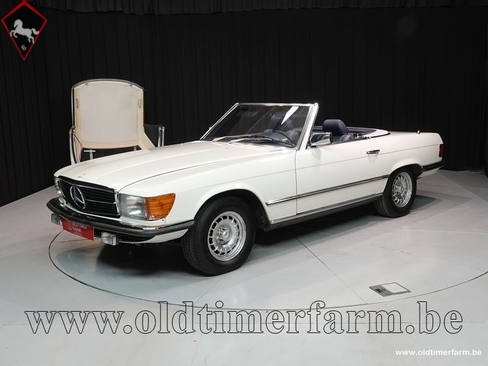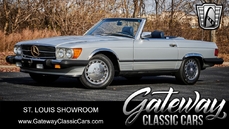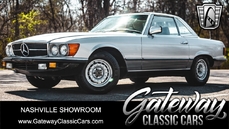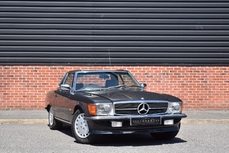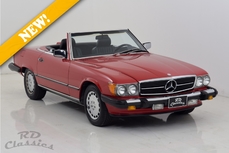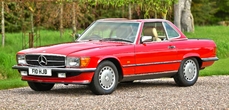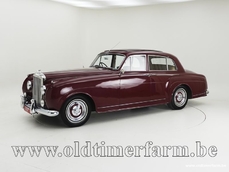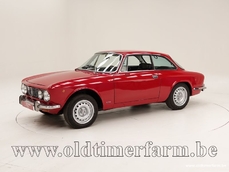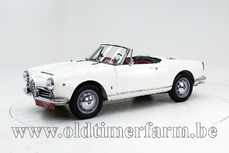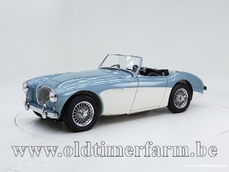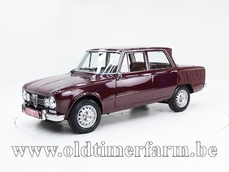Mercedes-Benz 500SL w107 SL R107 '83 1983
General description :
Looks very clean at first glance, even though it needs a little love EU car that has spent some time in the USA Bottle cap rims, a soft and hard top and a clean interior Backseat for two people (2+2) which is rare The Mercedes-Benz W107 was released in 1971. It was a true status symbol that extrudes performance and prestige. Its price, its specifications, and its performance show that this a a car only the lucky few can afford. The W107 also had the difficult task of succeeding the famous Pagoda, which still shared a strong resemblance to its predecessor, the Gullwing. With the W107, Mercedes-Benz took a leap into the unknown future, without leaving behind its trademarking luxury. Except the G-class, this is the Mercedes-Benz’s car that has been in production for the longest period, the production just stopped in 1989. The W107 came in two finishes. There was convertible R107 - or SL - with a soft-top, optional hard-top, and optional two-seat rear bench. Also, there was a C107 - or SLC - which was a two-door hard-top coupe with four seats. Both cars were available with a range of engines that all were impressive in their own right. Over the years, fewer engines were available, though each engine was made to perform. In 1981, the successor to the C107 was introduced, and production of it ended. The R107 continued to be sold in large numbers with three different engines until 1989. The total production number is estimated to be around 237,000 unique units. The aerodynamic and less rounded design was contemporary, compared to its predecessors. Though it was not Mercedes typical at the time, the curves were replaced, in order to fit its decade. The long hood and short rear emphasize class and exude sportiness, while the Mercedes’ star in the grille adds charisma and prestige. The interior is very recognizable as Mercedes, very luxurious, with a classic finish in leather and wood tones. For the US, a number of aesthetic adjustments were made based on their regulations. The square headlights were replaced with round ones, and the bumpers protruded to absorb a collision at five kilometres per hour without damage, as required by US law. Mercedes-Benz 500 SL R107 The Mercedes 500 SL was built during the second half of the W107 production period. It was introduced in 1980 in both the SL and SLC versions. The coupe version was replaced by the forerunners of the S-Class coupe in 1981. Nevertheless, the convertible SL did very well and remained in production until 1989. Under the hood, there is an outrageous 5.0-liter V8 engine that produces 240 horsepower. The 500 SL is the most powerful, charismatic, and expensive R107 that hit the market. The Mercedes luxury and the coquettish charm of the 80s steal hearts. Its two predecessors the Gullwing and the Pagoda have become unaffordable. The R107 is also on its way to acquire cult status, and at the time of writing, it is still affordable, although it is unsure how long this will remain unchanged. Technical information: Body work Length (cm): 439 (173 inch) Width (cm): 179 (70 inch) Height (cm): 130 (51 inch) Wheelbase (cm): 246 (87 inch) Weight (kg): 1540 (3395 lbs) (1580 kg/3483 lbs with hard top) Mechanics Engine: 4973 cc V8 front-engine Valve gear: 16 Fuel system: Bosch K-Jetronic Gear box: 4-speed automatic gearbox Transmission: RWD Left-steered power: 240 hp (177 kW) at 5000 t/m torque: 402 Nm at 3200 t/m Top speed: 215 km/h (134 mph)
1983 Mercedes-Benz 500SL w107 SL R107 '83 is listed for sale on ClassicDigest in Aalter by Oldtimerfarm for €32950.
Car Facts
Car type : Car Make : Mercedes-Benz Model : 500SL w107 Model Version : SL R107 '83 Engine size : 0.0 Model Year : 1983 Location : Aalter Vehicle Registration : Undefined
32950 €
Market Prices for Mercedes-Benz 500SL w107 from 2023 to 2025
Months
Mercedes-Benz 500SL w107 Selling Time to Price Correlation
0
6
12
18
24
30
36
42
48
54
0
20000
40000
60000
80000
ClassicDigest Market-O-Meter for Mercedes-Benz 500SL w107
Moderate Blue Chip Chart Busters
People who viewed this Mercedes-Benz 500SL w107 also viewed similar Mercedes-Benz listed at ClassicDigest
Other cars listed for sale by this dealer
About Mercedes-Benz
In the annals of automotive history, the journey of Mercedes-Benz is a tale that unfolds with the ingenuity of its founding pioneers. In the year 1886, Karl Benz crafted the Benz Patent Motorwagen, a creation that would go down in history as the world's inaugural automobile. Unbeknownst to him, this moment marked the genesis of what would evolve into the most illustrious premium car manufacturer globally. The financial underpinning of this pioneering venture, interestingly, was provided by Karl Benz's wife, Bertha Benz, demonstrating a remarkable partnership that would set the tone for Mercedes-Benz's legacy.A parallel narrative emerged not far away, as Daimler-Motoren-Gesellschaft, founded by Gottlieb Daimler and Wilhelm Maybach, entered the scene. In 1901, they unveiled their automobile under the now-famous moniker "Mercedes," meaning "godsend" in Spanish. This name was bestowed upon the car at the behest of Emil Jellinek's daughter, the distributor for Daimler-Motoren-Gesellschaft. The wheels of innovation were set in motion.
Fast forward to 1926, a pivotal year that witnessed the merger of Daimler with Benz & Cie., culminating in the birth of Daimler-Benz. The amalgamation saw the adoption of "Mercedes-Benz" as the distinguished trademark for their automobiles, fusing the legacies of two visionary entities into one.
Contrary to perceptions of conservatism, the trajectory of Daimler-Benz unfolds as a chronicle of industry firsts. From the introduction of the honeycomb radiator to the float carburetor, and the pioneering implementation of four-wheel brakes in 1924, Daimler-Benz consistently pushed the boundaries of automotive innovation. The diesel-powered Mercedes-Benz 260 D in 1936 marked the inception of diesel engines in passenger cars. The iconic Mercedes-Benz 300SL Gullwing made history as the first car with direct fuel injection, albeit the Gutbrod's tiny 2-stroke engine can claim precedence.
Safety innovations became a hallmark, with Béla Barényi's patented safety cell design in the "Ponton"-models in 1951, featuring front and rear crumple zones. The W116 450SEL 6.9 saw the introduction of the Anti-Lock Brake system (ABS), another pioneering safety feature. From the first production airbags and beyond, the legacy of "firsts" continued to be etched into the fabric of Daimler-Benz.
Over its centennial journey, Mercedes-Benz has not merely produced cars but has sculpted automotive icons. The SSKL, 710 SSK Trossi Roadster, 770K Grosser, 540K Spezial Roadster, 300SL Gullwing, w100 600 Pullman, w111 280SE 3.5 Flachkühler, w113 230SL Pagoda, w109 300 SEL 6.3, and w201 2.3-16 Cosworth stand testament to the brand's commitment to engineering excellence.
The roaring Silver Arrows, or "Silberpfeile," including the W 25, W 125, W154, W165, and W196, created a legacy of dominance on the racetrack. These machines were not merely cars; they were expressions of precision, speed, and an indomitable spirit that left their competitors in the dust.
As Mercedes-Benz marches into the future, it does so not just as an automaker but as a custodian of a legacy, a torchbearer of innovation, and a beacon of automotive excellence. The road ahead is sure to witness the continued fusion of cutting-edge technology, timeless design, and an unwavering commitment to setting new standards in the world of automobiles.
One luminary figure who left an indelible mark was Béla Barényi, often heralded as the "father of passive safety" for his pioneering work in safety engineering. His patented safety cell design, featuring front and rear crumple zones, became a hallmark of Mercedes-Benz's commitment to occupant safety, setting new standards that reverberated throughout the automotive world.
Moving through the chronicles, the collaborative genius of Wilhelm Maybach, alongside Gottlieb Daimler, laid the foundation for Daimler-Motoren-Gesellschaft. Their innovations not only birthed the first Mercedes but established a culture of relentless pursuit of technological excellence that remains integral to Mercedes-Benz's DNA.
In the post-merger era of 1926, Ferdinand Porsche emerged as a prominent figure within Mercedes-Benz. His work on the Mercedes-Benz S-Type, a supercharged race car, garnered acclaim and set the stage for a legacy that extended far beyond the marque. Porsche's impact would later extend to his eponymous company, but his influence at Mercedes-Benz during those formative years was pivotal.
As the 20th century progressed, the legendary Rudolf Uhlenhaut emerged as a key figure. Uhlenhaut, an accomplished engineer and the driving force behind the iconic Silver Arrows, played a crucial role in Mercedes-Benz's dominance in motorsports. His engineering prowess and attention to detail were instrumental in creating some of the most formidable racing cars of the era.
In the latter half of the century, figures like Bruno Sacco, the head of design at Mercedes-Benz from 1975 to 1999, left an indelible imprint on the brand's aesthetic identity. Sacco's design philosophy, characterized by clean lines and timeless elegance, shaped iconic models like the W126 S-Class and the W201 190E, solidifying Mercedes-Benz's reputation for luxury and sophistication.
The narrative would be incomplete without acknowledging the contributions of engineers like Hans Scherenberg, whose leadership in the 1970s ushered in a new era of technological innovation at Mercedes-Benz. Scherenberg's tenure saw the development of groundbreaking technologies, including the Anti-Lock Brake system (ABS) and the introduction of airbags in production cars.
